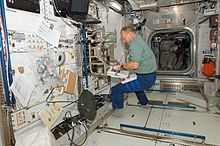 | |
| Module statistics | |
|---|---|
| Part of | International Space Station |
| Launch date | 7 February 2008, 19:45 UTC |
| Launch vehicle | Space Shuttle Atlantis |
| Berthed | 11 February 2008 (Harmony starboard) |


Columbus is a science laboratory that is part of the International Space Station (ISS) and is the largest single contribution to the ISS made by the European Space Agency (ESA).
Like the Harmony and Tranquility modules, the Columbus laboratory was constructed in Turin, Italy by Thales Alenia Space. The functional equipment and software of the lab was designed by EADS in Bremen, Germany. It was also integrated in Bremen before being flown to the Kennedy Space Center (KSC) in Florida in an Airbus Beluga. It was launched aboard Space Shuttle Atlantis on 7 February 2008, on flight STS-122. It is designed for ten years of operation. The module is controlled by the Columbus Control Centre, located at the German Space Operations Center, part of the German Aerospace Center in Oberpfaffenhofen near Munich, Germany.
The European Space Agency has spent €1.4 billion (about US$2 billion) on building Columbus, including the experiments it carries and the ground control infrastructure necessary to operate them.[1]
- ^ Harwood, William (11 February 2008). "Station arm pulls Columbus module from cargo bay". Spaceflightnow.com. Archived from the original on 7 May 2016. Retrieved 7 August 2009.